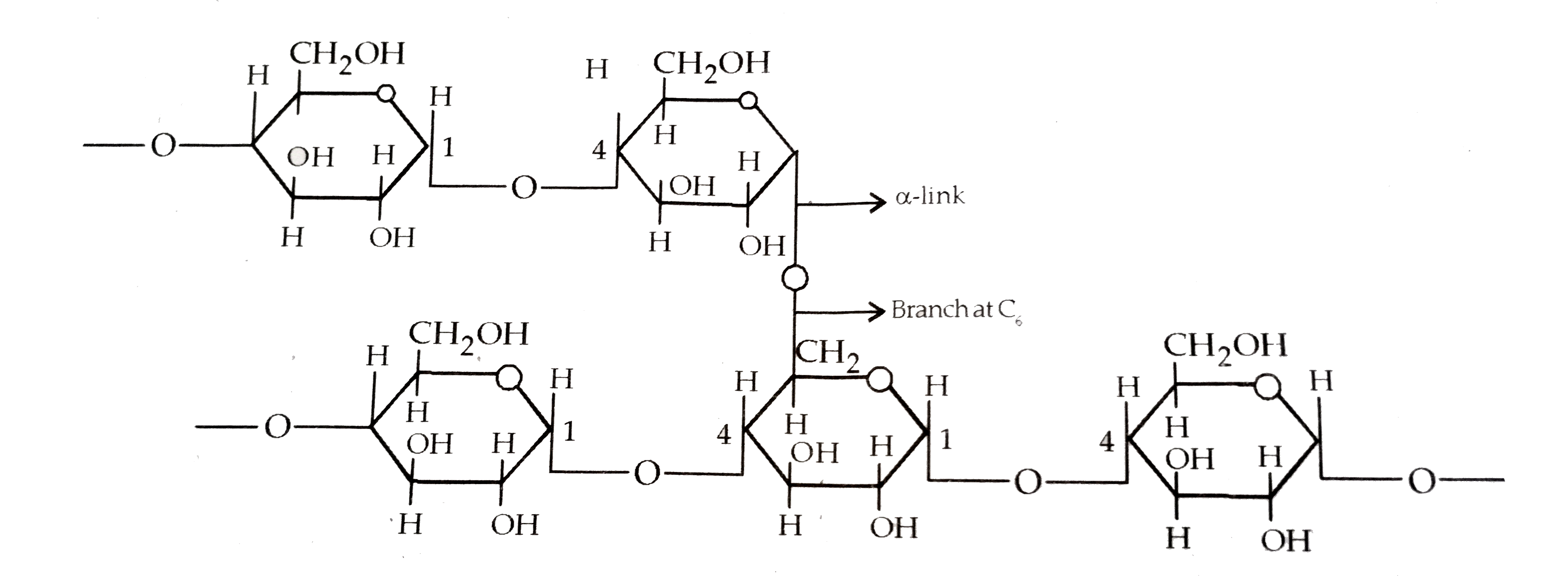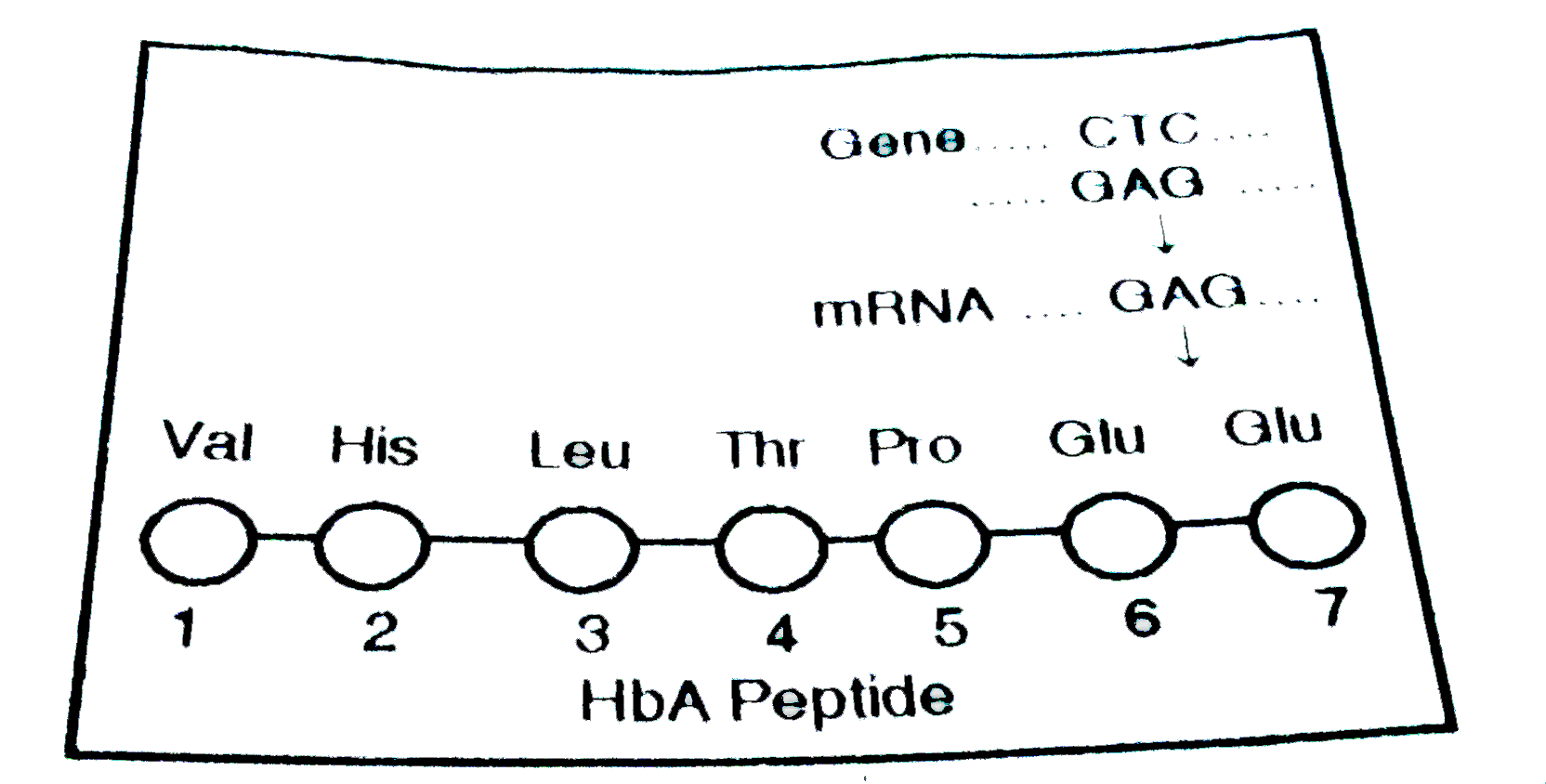Give any one property of glucose that cannot be explained by the open chain stucture
( b) Compare amylase in terms of constituting stucture .
(c )Why do amino acids show amphoteric behaviour ?
Glucose doent's undergo 2,4 -DNP test ,shcff 's test .Actually aldehyde give 2,4 -DNP test Schiff's test and react with NaHSO4 forms hydrogen sulphite addition product .
( b) Amylose is a long unbronched chain with 200- 1000 α- D-(+) glucose unnits held by Cl−C4 glycosidic linkage

Amylopection is a bronhed chain of aplha - D- glucose units in which the chain is formed by Cl−C4 glycosidic linkage ,whereas bronching occurs by C1-C6 glycoside linkage .

( c) The amphoteric behaviour of amino acids is explained when it is present in its aqueous state .In an acqueous solution , the carboxyl group of an amino acid can a lose a proton and the amino group can accept a proton.
Topper's Solved these Questions
- XII BOARDSBOOK - XII BOARDS PREVIOUS YEARCHAPTER - XII BOARDSEXERCISE - SECTION-D
12 Videos
- XII BOARDSBOOK - XII BOARDS PREVIOUS YEARCHAPTER - XII BOARDSEXERCISE - CHEMISTRY (Theory) [SET - I]
34 Videos
- XII BOARDSBOOK - XII BOARDS PREVIOUS YEARCHAPTER - XII BOARDSEXERCISE - SECTION-B
22 Videos
- SAMPLE PAPER 2019BOOK - XII BOARDS PREVIOUS YEARCHAPTER - SAMPLE PAPER 2019EXERCISE - SECTION: D
1 Videos
Similar Questions
Give any one property of glucose that cannot be explained by the open chain stucture
( b) Compare amylase with amylopectin in terms of constituting stucture .
(c )Why do amino acids show amphoteric behaviour ?
View SolutionGive one reaction of D-glucose which cannot be explained by its open chain structure.
View Solution(i) Write one reaction of D-Glucose which cannot be explained by its open chain structure.
(ii) What type of linkage is present in Nucleic acids ?
(iii) Give one example each for water-soluble vitamins and fat-soluble vitamins ?
View SolutionRead the given passage ans answer question number 1 to 5 that follow :
Amino acids are classified as acidic, baisc or neutral depending unpon the relative number of makes it neutral , more number of amino than carboxyl groups makes it basic and more carboxyl groups are compared to amino groups makes it acidic . The amino acids , which can be synthesised in the body and must be obtained through diet , are known as essential amino acids. Amino acids are usually colourless, crystalline solids . These are water -solute , high melting solids and behave like salts rather than simple amines or carboxylic acids . This behaviour is due to the presence of both acidic (carboxyl group) and basic (amino group) in the same mlecule . In aqueous solution , the carboxyl group can lose a proton and amino group can accept a proton , giving rise to a dipolar ion known as zwitter ion. This is neutral but contains both positive and negative charges. In zwitter ionic , form amino acids show amphoteric behaviour as they react both with acids and bases.
An amino acid contains two amino and one carboxylic group. In which class of amino acids would you place it ?
View SolutionRead the given passage ans answer question number 1 to 5 that follow :
Amino acids are classified as acidic, baisc or neutral depending unpon the relative number of makes it neutral , more number of amino than carboxyl groups makes it basic and more carboxyl groups are compared to amino groups makes it acidic . The amino acids , which can be synthesised in the body and must be obtained through diet , are known as essential amino acids. Amino acids are usually colourless, crystalline solids . These are water -solute , high melting solids and behave like salts rather than simple amines or carboxylic acids . This behaviour is due to the presence of both acidic (carboxyl group) and basic (amino group) in the same mlecule . In aqueous solution , the carboxyl group can lose a proton and amino group can accept a proton , giving rise to a dipolar ion known as zwitter ion. This is neutral but contains both positive and negative charges. In zwitter ionic , form amino acids show amphoteric behaviour as they react both with acids and bases.
What is meant by amphoteric character ?
View SolutionRead the given passage ans answer question number 1 to 5 that follow :
Amino acids are classified as acidic, baisc or neutral depending unpon the relative number of makes it neutral , more number of amino than carboxyl groups makes it basic and more carboxyl groups are compared to amino groups makes it acidic . The amino acids , which can be synthesised in the body and must be obtained through diet , are known as essential amino acids. Amino acids are usually colourless, crystalline solids . These are water -solute , high melting solids and behave like salts rather than simple amines or carboxylic acids . This behaviour is due to the presence of both acidic (carboxyl group) and basic (amino group) in the same mlecule . In aqueous solution , the carboxyl group can lose a proton and amino group can accept a proton , giving rise to a dipolar ion known as zwitter ion. This is neutral but contains both positive and negative charges. In zwitter ionic , form amino acids show amphoteric behaviour as they react both with acids and bases.
What are essintal amino acids
View SolutionRead the given passage ans answer question number 1 to 5 that follow :
Amino acids are classified as acidic, baisc or neutral depending unpon the relative number of makes it neutral , more number of amino than carboxyl groups makes it basic and more carboxyl groups are compared to amino groups makes it acidic . The amino acids , which can be synthesised in the body and must be obtained through diet , are known as essential amino acids. Amino acids are usually colourless, crystalline solids . These are water -solute , high melting solids and behave like salts rather than simple amines or carboxylic acids . This behaviour is due to the presence of both acidic (carboxyl group) and basic (amino group) in the same mlecule . In aqueous solution , the carboxyl group can lose a proton and amino group can accept a proton , giving rise to a dipolar ion known as zwitter ion. This is neutral but contains both positive and negative charges. In zwitter ionic , form amino acids show amphoteric behaviour as they react both with acids and bases.
What are the different classes of amino acids ?
View SolutionRead the given passage ans answer question number 1 to 5 that follow :
Amino acids are classified as acidic, baisc or neutral depending unpon the relative number of makes it neutral , more number of amino than carboxyl groups makes it basic and more carboxyl groups are compared to amino groups makes it acidic . The amino acids , which can be synthesised in the body and must be obtained through diet , are known as essential amino acids. Amino acids are usually colourless, crystalline solids . These are water -solute , high melting solids and behave like salts rather than simple amines or carboxylic acids . This behaviour is due to the presence of both acidic (carboxyl group) and basic (amino group) in the same mlecule . In aqueous solution , the carboxyl group can lose a proton and amino group can accept a proton , giving rise to a dipolar ion known as zwitter ion. This is neutral but contains both positive and negative charges. In zwitter ionic , form amino acids show amphoteric behaviour as they react both with acids and bases.
What is zwitter ion?
View Solution(a) What is meant by
(i) peptide linkage (ii) biocatalysts?
(b) Write any two reactions of glucose which cannot be explained by the open chain structure of glucose molecule.
View SolutionGiven below is the representation of a relevant part of amino acid composition of the β-chain of haemoglobin, related to the shape of human red blood cells.

(a) Is this representation of the sequence of amino acids indicating a normal human or a sufferer from a certain blood related genetic disease ? Give reason in support of your answer.
(b) Why is the disease referred to as a Mendelian disorder ? Explain.
View Solution
